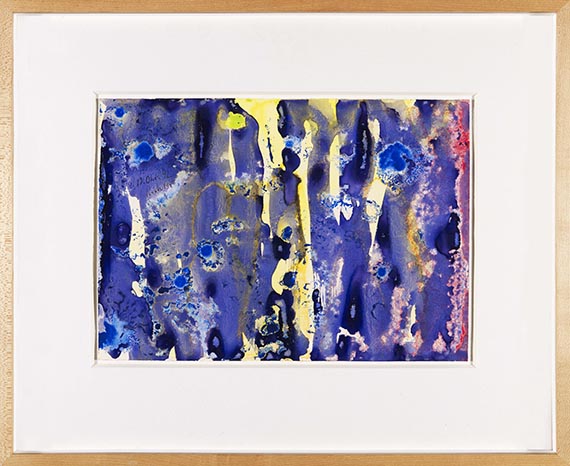9
Gerhard Richter
13. Okt. 92, 1992.
Watercolor
Estimation:
€ 140,000 / $ 149,800 Résultat:
€ 190,500 / $ 203,835 ( frais d'adjudication compris)
13. Okt. 92. 1992.
Watercolor.
Signed and dated in the upper left of the image. Once more signed and dated on the reverse. 24 x 33.7 cm (9.4 x 13.2 in), the full sheet.
• Watercolors, which the artist stopped making in March 1997, make for a small but very important group in his œuvre.
• Transparent and yet opaque color application: Richter fully explores the creative potential of the watercolor.
• Watercolors in this intensity, colorfulness and freshness are of the utmost rarity.
The work is mentioned in the online catalogue raisonné.
PROVENANCE: Marian Goodman Gallery, New York.
Private collection, New York.
Private collection Southern Germany (since 1995).
"Among the watercolors, we hardly find any representational ones made on basis of photographs or other templates. Because the abstract ones are more exciting and much faster; the effect is similar to my earlier enthusiasm for developing photos in the darkroom. Something comes into being all by itself, you just have to make sure to intervene the right moment, in this case, to stop it. So this is more about making decisions than to take action."
Gerhard Richter in an interview with Dieter Schwarz in 1999.
Watercolor.
Signed and dated in the upper left of the image. Once more signed and dated on the reverse. 24 x 33.7 cm (9.4 x 13.2 in), the full sheet.
• Watercolors, which the artist stopped making in March 1997, make for a small but very important group in his œuvre.
• Transparent and yet opaque color application: Richter fully explores the creative potential of the watercolor.
• Watercolors in this intensity, colorfulness and freshness are of the utmost rarity.
The work is mentioned in the online catalogue raisonné.
PROVENANCE: Marian Goodman Gallery, New York.
Private collection, New York.
Private collection Southern Germany (since 1995).
"Among the watercolors, we hardly find any representational ones made on basis of photographs or other templates. Because the abstract ones are more exciting and much faster; the effect is similar to my earlier enthusiasm for developing photos in the darkroom. Something comes into being all by itself, you just have to make sure to intervene the right moment, in this case, to stop it. So this is more about making decisions than to take action."
Gerhard Richter in an interview with Dieter Schwarz in 1999.
In Richter's oeuvre, watercolors appear in nondistinctive intervals. He made first watercolors and drawings, which, like his paintings, were based on photographs, in 1964. From then on, the works on paper would appear at longer intervals and mostly in series. A more intensive occupation with watercolor painting began in the late 1970s and reached a climax in the 1980s. However, it was not until 1985 that the artist had a first exhibition of watercolors at the Staatsgalerie Stuttgart. In early days, Richter thought that watercolor art was too playful, and he feared that resulting sheets could be too seductive, too "arty". In general, the medium of watercolor painting played a subordinate role in post-war modern art, and would only gain increased recognition as a means of expression through artists such as Beuys, Tuttle, Palermo, Polke, Baselitz, Graubner and Gerhard Richter in the 1980s. In terms of form, the artist faced the same questions, regardless whether he was working in oil or watercolor. He tried to transfer the expressive potential of the watercolor and its airiness onto the big canvas. What the artist appreciates the most is the work process that only the watercolor allows – pouring and dripping - the result cannot be exactly planned. This creates a certain "nonchalance" (G. Richter, in: Dieter Schwarz, Gerhard Richter: Zeichnungen 1964-1999, Düsseldorf 1999, p. 7.) that is difficult to achieve in oil paintings and that is particularly important to Richter, since it allows the artist to take a step back and to let material and color take center stage. The composition from October 13, 1992, is dominated by a purple-blue with yellow and pink tones shining through. Richter manages to structure the color’s materiality. The seemingly orderly network of lines is broken up by drop-shaped structures. Various superimposed color structures show an abstract, material-like treatment of the color, so that the result always reveals traces from the process of its creation. At a time when it was widely believed that it had already been exhausted, Gerhard Richter succeeded in creating a new form of abstract painting, and created images that offer an independent visual experience. [SM]
9
Gerhard Richter
13. Okt. 92, 1992.
Watercolor
Estimation:
€ 140,000 / $ 149,800 Résultat:
€ 190,500 / $ 203,835 ( frais d'adjudication compris)




 Lot 9
Lot 9 
